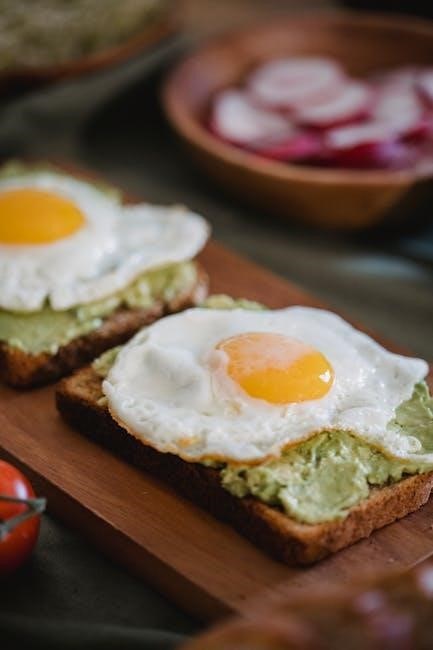
egg steamer instructions
Welcome to your egg steamer instructions guide! This comprehensive manual will help you master the art of perfectly cooking eggs using your egg steamer. Discover how to achieve soft-‚ medium-‚ or hard-boiled eggs effortlessly. Learn proper preparation‚ safety tips‚ and maintenance to ensure optimal performance. Follow these step-by-step instructions for delicious‚ consistent results every time. Happy cooking!
Overview of Egg Steaming
Egg steaming is a simple and efficient method for cooking eggs to your desired doneness. By using steam‚ eggs are gently cooked without direct heat‚ preserving their flavor and texture. The process typically involves adding water to the base unit‚ piercing the eggs to prevent cracking‚ and placing them in the egg tray. The steamer then generates steam‚ cooking the eggs evenly. This method allows for precise control over cooking time‚ ensuring soft-‚ medium-‚ or hard-boiled results. It’s a convenient and healthy way to prepare eggs without constant monitoring‚ making it ideal for breakfast or meal prep.
Why Use an Egg Steamer?
An egg steamer offers a convenient and consistent way to cook eggs to your desired doneness. It ensures even cooking without the risk of overcooking‚ making it ideal for achieving perfect soft-‚ medium-‚ or hard-boiled eggs. The steamer is easy to use‚ requiring minimal effort and no direct supervision. It’s also a healthier option as it doesn’t require oil for cooking. Additionally‚ the steamer helps retain the eggs’ natural flavors and nutrients‚ providing a tastier and more nutritious result. With its compact design and straightforward operation‚ an egg steamer is a practical addition to any kitchen‚ perfect for breakfast‚ meal prep‚ or snacks.
Benefits of Steaming Eggs
Steaming eggs offers numerous benefits‚ making it a preferred cooking method for many. It preserves the delicate flavors and nutrients of eggs better than boiling‚ as it uses gentle heat. Steaming also reduces the risk of overcooking‚ ensuring a tender texture. This method is healthier since it doesn’t require oil‚ making it ideal for those watching their diet. Additionally‚ steaming eggs is mess-free and easy to clean up. The consistent results and versatility in achieving different levels of doneness make steaming a convenient and efficient way to prepare eggs for any meal. It’s a simple yet effective way to enjoy eggs at their best.

Components of an Egg Steamer
An egg steamer typically includes a base unit‚ water reservoir‚ egg tray‚ lid‚ and measuring cup. These parts work together to ensure efficient and even cooking of eggs.
Base Unit
The base unit of an egg steamer is the core component that houses the heating element and electronic controls. It connects to the power supply and operates the entire system. The base unit contains sensors to monitor water levels and temperature‚ ensuring safe and efficient cooking. It also features buttons or a dial for setting the timer and selecting cooking modes. Proper cleaning of the base unit is essential to maintain performance and longevity. Always unplug the steamer before cleaning and use a soft‚ damp cloth to wipe down the exterior and interior surfaces. Regular maintenance prevents mineral buildup and ensures consistent results.
Water Reservoir
The water reservoir is a detachable component of the egg steamer that holds the water used for generating steam. It is typically located at the base of the unit and has a clear marker to indicate the maximum water level. Before cooking‚ fill the reservoir with cold water to the recommended level using the measuring cup provided. Avoid overfilling‚ as this can lead to excessive steam and uneven cooking. The reservoir is designed for easy removal and refilling‚ ensuring convenient operation. Regularly cleaning the reservoir with a soft cloth and descaling it every few months will prevent mineral buildup and maintain optimal performance. Proper water level management ensures consistent cooking results. Always align the reservoir correctly with the base unit to avoid leakage during operation.
Egg Tray
The egg tray is a removable‚ dishwasher-safe component designed to hold eggs securely during steaming; It typically accommodates 4-7 eggs‚ depending on the model‚ and features holes for even steam distribution. Place eggs gently into the tray‚ ensuring they do not overlap to avoid cracking. After steaming‚ the tray allows for safe and easy removal of hot eggs. Regularly clean the tray with a soft cloth and mild detergent to prevent residue buildup. Some trays include a handle for convenient lifting. Always ensure the tray is properly aligned with the base unit to maintain stability during cooking. Proper use of the egg tray ensures consistent cooking results and prevents eggs from breaking. Cleaning the tray regularly helps maintain hygiene and longevity. Always refer to the manufacturer’s guidelines for specific tray care instructions.
Lid
The lid is an essential component of the egg steamer‚ designed to trap steam and ensure even cooking. It is typically made of transparent material‚ allowing you to monitor the cooking process without removing it. The lid fits snugly over the egg tray to prevent steam from escaping‚ promoting efficient cooking. Some lids feature a small vent to release excess steam and prevent pressure buildup. Always ensure the lid is securely closed before turning on the steamer. For safety‚ use the handle to lift the lid‚ as it may be hot. Cleaning the lid regularly with a soft cloth and mild detergent will maintain its clarity and functionality. Proper lid alignment is crucial for optimal performance and even cooking results.
Measuring Cup
The measuring cup is a crucial accessory for your egg steamer‚ helping you add the precise amount of water needed for cooking. It often features graduated markings to indicate water levels for soft-‚ medium-‚ or hard-boiled eggs. Some measuring cups include a built-in pin for piercing eggs‚ which helps prevent cracking during cooking. To use it correctly‚ fill the cup to the desired level and pour the water into the base unit. Ensure the water level aligns with the markings for your preferred egg doneness. After each use‚ wash the measuring cup with mild detergent and rinse thoroughly to maintain hygiene. Proper use of the measuring cup ensures consistent cooking results and extends the lifespan of your egg steamer.

Preparation Steps
Before using your egg steamer‚ ensure all parts are clean and assembled correctly. Wipe the base with a damp cloth and dry thoroughly. Pierce eggs using the pin‚ measure water accurately‚ and place eggs in the tray. Follow these steps to prepare for a seamless cooking experience.
Before First Use
Before using your egg steamer for the first time‚ clean all components thoroughly. Wipe the main body with a soft‚ damp cloth and ensure it dries completely. Check the water reservoir for any residue and rinse if necessary. If there’s limescale buildup‚ descale the steamer before use. Allow all parts to dry to prevent water spots. This preparation ensures your egg steamer is ready for safe and efficient cooking. Always follow the manufacturer’s guidelines for initial setup and maintenance to guarantee optimal performance and longevity of your appliance.
Cleaning the Egg Steamer
Regular cleaning is essential to maintain your egg steamer’s efficiency and hygiene. After each use‚ wipe the main body with a soft‚ damp cloth. Remove any food residue from the egg tray and rinse it under warm water. For the water reservoir‚ empty it completely and rinse thoroughly to prevent mineral buildup. If limescale forms‚ descale the steamer using a mixture of water and vinegar or a descaling solution. Avoid using abrasive cleaners or scrubbers‚ as they may damage the surfaces. Dry all parts thoroughly after cleaning to prevent water spots and bacterial growth. Keeping your steamer clean ensures optimal performance and longevity.
Assembling the Egg Steamer

To assemble your egg steamer‚ start by placing the base unit on a flat‚ stable surface. Next‚ fill the water reservoir with cold water according to the recommended level‚ then place it securely into the base. Carefully position the egg tray on top of the reservoir‚ ensuring it aligns with the base. Gently place the lid on the egg tray to complete the setup. Make sure all components are properly aligned and fitted to ensure smooth operation. Plug in the power cable and your steamer is ready for use. Always refer to the manual for specific assembly instructions to avoid any issues. Proper assembly ensures safety and optimal performance.
Preparing the Eggs
Before cooking‚ gently place the eggs on a clean‚ flat surface. Use the piercing pin located on the measuring cup to create a small hole in the larger end of each egg. This step prevents cracking during cooking. Ensure eggs are clean and dry to avoid steam obstruction. For even cooking‚ place eggs with the pierced end facing downward in the egg tray. Avoid overcrowding the tray to allow proper steam circulation. Handle eggs carefully to prevent breakage. Once prepared‚ your eggs are ready to be steamed to your desired doneness. Proper preparation ensures consistent results and prevents mess during the cooking process.
Measuring Water
Accurate water measurement is crucial for perfect egg cooking. Use the provided measuring cup to add the right amount of water‚ as specified in the instructions. For soft-boiled eggs‚ use less water‚ while hard-boiled eggs require more. Ensure the water level aligns with the marked guidelines on the reservoir. Always use cold water to prevent overheating. Avoid overfilling‚ as this can lead to overcooking; Proper water measurement ensures even steam distribution‚ resulting in consistent cooking results. Once measured‚ pour the water into the base unit carefully. This step is essential for achieving your desired egg doneness and maintaining the steamer’s efficiency.

Cooking Options
Explore versatile cooking options with your egg steamer! Achieve soft-‚ medium-‚ or hard-boiled eggs and even poached eggs effortlessly. Customize your cooking preferences with ease and precision.
Soft-Boiled Eggs
Soft-boiled eggs are a delicious and popular choice‚ offering a runny yolk surrounded by a set white. To achieve this‚ fill the water reservoir with the recommended amount of water. Pierce the large end of each egg using the pin on the measuring cup to prevent cracking. Place the eggs in the egg tray‚ leaving space between them for even cooking. Set the timer according to the manufacturer’s guidelines for soft-boiled eggs‚ typically 6-8 minutes. Once cooked‚ immediately transfer the eggs to an ice bath or rinse them under cold water to stop the cooking process. Serve and enjoy your perfectly cooked soft-boiled eggs!
Medium-Boiled Eggs
Medium-boiled eggs offer a perfect balance between a slightly runny yolk and a fully set white. To achieve this‚ add water to the reservoir as per the instructions. Pierce each egg at the larger end using the provided pin to prevent cracking. Place the eggs in the egg tray‚ ensuring they are evenly spaced. Set the timer according to the medium-boiled setting‚ typically around 8-10 minutes. Once the timer goes off‚ immediately transfer the eggs to an ice bath or rinse them under cold water to stop the cooking process. This method ensures a creamy yolk and a fully cooked white‚ ideal for a variety of dishes or snacks.
Hard-Boiled Eggs
Hard-boiled eggs are a versatile and convenient option for snacks‚ salads‚ or meal prep. To achieve perfectly cooked hard-boiled eggs‚ add water to the steamer’s reservoir as instructed. Pierce each egg at the larger end using the pin provided to prevent cracking. Place the eggs in the egg tray‚ ensuring they are evenly spaced. Set the timer according to the hard-boiled setting‚ typically around 12-15 minutes. Once the timer sounds‚ immediately transfer the eggs to an ice bath or rinse them under cold water to halt cooking. This method ensures a fully set yolk and white‚ making them ideal for slicing‚ chopping‚ or peeling for various recipes.
Poached Eggs
Poached eggs are a delicate and flavorful option‚ perfect for breakfast or brunch. To poach eggs using your steamer‚ start by adding water to the reservoir. Place the eggs in the egg tray‚ ensuring they are spaced evenly; Cover the steamer with the lid to trap steam. Set the timer according to the poaching setting‚ usually around 6-8 minutes. Once cooked‚ carefully remove the eggs with a spatula and rinse them under cold water to stop cooking. The result is a soft‚ runny yolk surrounded by a set white‚ ideal for dishes like Eggs Benedict or avocado toast. For best results‚ use fresh eggs and avoid overcrowding the tray.

Cooking Process
- Add water to the base unit as per instructions.
- Pierce each egg using the pin on the measuring cup.
- Gently place eggs into the egg tray.
- Set the timer based on desired doneness.
- Turn on the steamer and wait for completion.
Adding Water
Adding water is a crucial step in the egg steaming process. Always use cold water for optimal results‚ as it helps prevent eggs from cracking due to sudden temperature changes. Fill the water reservoir to the recommended level using the provided measuring cup. Ensure the water level aligns with the markings on the reservoir to avoid overfilling or underfilling. Proper water levels ensure consistent steam generation‚ which directly affects cooking time and egg doneness. Once the water is added‚ proceed to place the eggs in the tray and set the timer. Avoid using hot water‚ as it may cause the eggs to cook unevenly or lead to overcooking.
Piercing the Eggs
Piercing the eggs is an essential step before steaming to ensure even cooking and prevent cracking. Use the small pin located on the bottom of the measuring cup to create a tiny hole in the large end of each egg. This allows steam to enter the egg‚ promoting consistent cooking and reducing the risk of the egg exploding during the process. Gently pierce each egg‚ being careful not to apply too much pressure‚ which could cause breakage. Once all eggs are pierced‚ they are ready to be placed in the egg tray for steaming. This step is crucial for achieving perfectly cooked eggs every time.
Placing Eggs in the Tray
After piercing‚ gently place the eggs into the egg tray‚ ensuring they are evenly spaced and not overcrowded. Position each egg with the pierced end facing upwards to allow steam to circulate properly. Avoid stacking eggs‚ as this can lead to uneven cooking or breakage. The tray is typically designed to hold a specific number of eggs‚ so refer to your model’s capacity. Once all eggs are in place‚ align the tray with the base unit and lower it gently. Close the lid to ensure steam is retained for efficient cooking. Proper placement ensures consistent results and prevents eggs from moving during the steaming process.
Setting the Timer
Setting the timer is crucial for achieving perfectly cooked eggs. Once the eggs are placed in the tray‚ locate the timer on your egg steamer. Refer to the markings or instructions provided with your model to determine the correct cooking time based on your desired doneness—soft‚ medium‚ or hard-boiled. Gently turn the timer dial or press the button to set the time. Ensure it clicks or beeps to confirm the setting. Once set‚ the steamer will automatically shut off when the timer expires. After the timer goes off‚ turn off the steamer and allow any remaining steam to escape before opening the lid. This ensures your eggs are cooked to perfection without overcooking.
Turning On the Steamer
To turn on the egg steamer‚ ensure it is properly assembled and placed on a stable‚ heat-resistant surface. Plug the power cord into a nearby electrical outlet. Locate the power button‚ usually found on the base or control panel‚ and press it to activate the steamer. You may hear a gentle humming noise or see indicator lights as it powers up. Check that the water reservoir has the correct amount of water and the egg tray is securely in place. Once turned on‚ the steamer will begin to heat the water and produce steam. Allow it to preheat for a few moments before proceeding. Avoid opening the lid during operation to maintain steam levels. Always ensure the steamer is turned off after use.

Safety Tips
Always handle hot eggs with care and use the measuring cup to avoid overcooking. Never leave the steamer unattended while in use. Keep children away and ensure the power cord is away from water to prevent accidents.
Handling Hot Eggs
Always handle hot eggs with extreme care to avoid burns. Use tongs‚ a spatula‚ or the egg tray handle to remove eggs from the steamer. Never touch hot eggs with bare hands. Allow eggs to cool slightly before peeling‚ especially for soft- or medium-boiled eggs. For hard-boiled eggs‚ rinse under cold water immediately after cooking to stop the cooking process and make them easier to handle. Always place hot eggs on a heat-resistant surface and keep them out of reach of children. Wearing kitchen gloves can provide extra protection when dealing with hot eggs or the steamer components.
Preventing Overcooking
Preventing overcooking is essential for achieving perfectly cooked eggs. Use the timer feature on your egg steamer to set precise cooking times based on your desired doneness. For soft-boiled eggs‚ cook for 10-12 minutes‚ medium-boiled for 12-15 minutes‚ and hard-boiled for 15-18 minutes. Always measure water accurately using the provided cup‚ as excess water can extend cooking time. After cooking‚ immediately transfer eggs to an ice bath or rinse them under cold water to stop the cooking process; Regularly cleaning the steamer ensures consistent performance and accurate timing. Adjust settings as needed based on egg size and personal preference to avoid overcooking and enjoy perfectly cooked eggs every time.
Using the Measuring Cup Correctly
The measuring cup is essential for accurate water measurement. Fill it to the level corresponding to your desired egg type: soft-boiled‚ medium‚ or hard-boiled. Pierce each egg gently with the cup’s pin to prevent cracking. Place eggs in the tray‚ add measured water to the base‚ and set the timer accordingly. Avoid overcooking by ensuring the timer is set correctly and eggs are promptly removed and rinsed. Clean the cup regularly to maintain accuracy. Adhere to these steps for perfectly cooked eggs every time. Practice makes perfect‚ so start with soft-boiled and adjust as needed. Proper use ensures optimal results and longevity of your egg steamer.

Maintenance and Cleaning
Regularly clean the egg steamer with a damp cloth and descale it to remove mineral buildup. Store the appliance in a dry place to maintain performance and longevity.

Regular Cleaning
Regular cleaning is essential for maintaining your egg steamer’s performance and hygiene. After each use‚ wipe the main body with a soft‚ damp cloth and dry thoroughly. The egg tray and water reservoir should be washed with mild detergent and warm water‚ then rinsed and dried. Avoid using abrasive materials that could scratch the surfaces. For tough stains‚ soak parts in warm soapy water before cleaning. Always rinse thoroughly to remove any soap residue. Regular cleaning prevents mineral buildup and bacterial growth‚ ensuring your steamer continues to function effectively and safely. Clean the lid and exterior with a damp cloth to keep it looking new.
Descale the Steamer
Descale your egg steamer regularly to remove mineral buildup from hard water‚ which can affect performance and hygiene. Mix equal parts water and white vinegar or use a descaling solution in the water reservoir. Pour the mixture into the base‚ ensuring it covers the heating element. Let it sit for 30 minutes to an hour before rinsing thoroughly with clean water. For heavy buildup‚ repeat the process. Descaling every 1-3 months prevents limescale accumulation and ensures efficient steam generation. This maintenance step is crucial for prolonging the life of your steamer and maintaining consistent cooking results. Always rinse well to remove any vinegar taste.
Storing the Steamer
Properly storing your egg steamer ensures longevity and prevents damage. After cleaning and drying‚ disconnect the power cord and store the unit in a cool‚ dry place. Avoid exposure to direct sunlight or extreme temperatures. Do not store the steamer near open flames or heat sources. Ensure all components‚ such as the egg tray and measuring cup‚ are clean and dry before storage. Store them separately in a protective bag to prevent scratches. Keep the user manual with the steamer for easy reference. Regular storage maintenance helps preserve functionality and ensures your egg steamer remains in excellent condition for future use.

Troubleshooting Common Issues
Identify and resolve common problems with your egg steamer‚ such as eggs not cooking evenly‚ water level issues‚ or the steamer not turning on. Refer to the troubleshooting section for solutions to ensure optimal performance and address any malfunctions promptly. Regular maintenance and proper usage can prevent many issues. Always follow the manufacturer’s guidelines for resolving problems and maintaining your egg steamer. This section will guide you through diagnosing and fixing common concerns effectively. Ensure your egg steamer operates smoothly by addressing issues early and correctly. Happy cooking!
Eggs Not Cooking Properly
If your eggs are not cooking properly‚ check the water level and ensure the steamer is turned on. Verify that the eggs are pierced correctly to allow steam to enter. Make sure the timer is set according to your desired doneness. If eggs are undercooked‚ increase the cooking time slightly. For overcooked eggs‚ reduce the timer. Ensure the lid is securely closed to maintain steam. Check the power connection and confirm the steamer is functioning. If issues persist‚ refer to the troubleshooting guide for further assistance. Proper preparation and adherence to instructions are key to achieving perfectly cooked eggs every time. Adjust settings as needed for consistent results. Always follow the manufacturer’s guidelines for optimal performance. If problems continue‚ consult the user manual or contact customer support. Regular maintenance can also prevent such issues. Happy cooking!
Water Level Issues
Water level issues can affect the performance of your egg steamer. Ensure the water reservoir is filled to the recommended level using the provided measuring cup. Insufficient water may prevent proper steam generation‚ while excessive water can cause overflow. Always use cold water‚ as hot water may damage the unit. If the water level is too low‚ the eggs may not cook evenly; Check the water reservoir before each use and adjust as needed. If the steamer leaks or the water level drops too quickly‚ inspect for any blockages or damage. Proper water level maintenance ensures consistent cooking results. Refer to the user manual for specific guidelines. Adjusting the water level correctly will help you achieve perfectly cooked eggs every time. Regular checks can prevent such issues. Always follow the manufacturer’s instructions for optimal performance. Happy cooking!
Steamer Not Turning On
If your egg steamer fails to turn on‚ ensure it is properly plugged into a functioning power outlet. Check the power cord for any visible damage or tangles. Verify that the outlet is working by testing it with another appliance. Make sure the egg tray and lid are correctly assembled‚ as some models require these components to be in place to operate. If the issue persists‚ unplug the steamer‚ allow it to cool‚ and restart it. Consult the user manual for troubleshooting specific to your model. If none of these steps resolve the issue‚ contact customer support for assistance. Proper electrical connections are essential for the steamer to function. Always follow safety guidelines when addressing electrical concerns. Ensure all parts are securely locked before turning it on. This will help maintain your steamer’s performance and longevity. If the problem continues‚ professional servicing may be required. Always prioritize safety when dealing with electrical appliances.
With these comprehensive egg steamer instructions‚ you’re now equipped to prepare perfect eggs every time. From soft-boiled to hard-boiled‚ and even poached‚ your egg steamer offers versatility and convenience. By following the preparation steps‚ cooking options‚ and maintenance tips‚ you’ll extend the life of your appliance and enjoy consistent results. Remember to prioritize safety‚ especially when handling hot eggs and components. Troubleshooting common issues ensures minimal downtime‚ keeping your cooking routine smooth. Experiment with different settings to find your favorite way to cook eggs. Happy cooking‚ and enjoy the delicious benefits of your egg steamer!